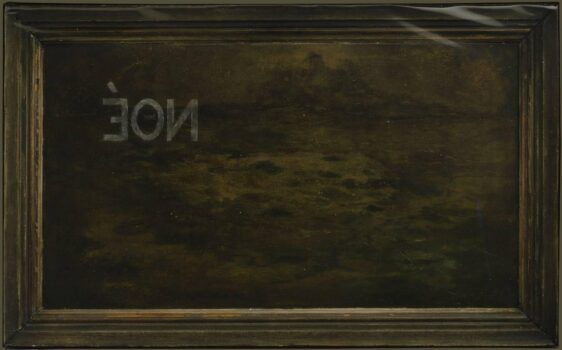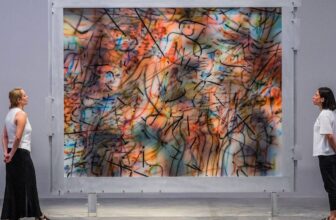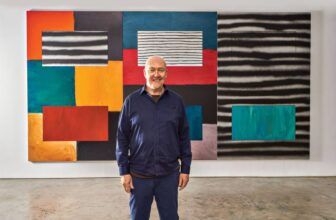What are Famous Paintings by Francis Alys
In the dusty streets of Mexico City, a man walks slowly, trailing behind him a block of ice. It’s midday, the sun beats down harshly, and pedestrians look on curiously. The ice leaves a trail of water that evaporates almost as quickly as it forms. This isn’t performance art in a gallery; it’s the city itself that becomes the stage, and the act, the walk, is the art.
The man pulling the block of ice is Francis Alys, a Belgian-born artist whose practice defies categorization. Part painter, part urban explorer, part documentarian, Alys has spent decades challenging traditional notions of what art can be. His projects blend conceptual rigor with poetic absurdity. They ask: What happens when art leaves the studio and enters the chaos of the real world?
Who is Francis Alys?
Born in 1959 in Antwerp, Belgium, Francis Alys originally trained as an architect, earning a degree from the Institut d’Architecture de Tournai and later studying urbanism in Venice. In 1986, he moved to Mexico City as part of a humanitarian aid project after the devastating 1985 earthquake. What was meant to be a short-term assignment became a lifelong home and source of inspiration.
Alys’ early exposure to the architectural complexity and socio-political dynamics of Mexico shaped his understanding of space, movement, and the invisible systems that govern city life. It was in Mexico that he transitioned from architecture to art, gradually developing a body of work that would come to encompass painting, video, performance, installation, and social practice.
What Is Francis Alys Known For?
Alys is best known for his performative and often politically charged actions in urban environments, many of which he documents through video, photographs, and narrative texts. These actions are deceptively simple yet rich with metaphor and social critique.
Some of his most famous projects include:
“The Green Line” (2004–2005): Alys walked through Jerusalem carrying a can of green paint with a hole in it, letting the paint drip along the path of the 1949 Armistice line (also known as the Green Line). This act, which drew attention to contested geopolitical boundaries, raised questions about occupation, memory, and visibility.
“When Faith Moves Mountains” (2002): In Peru, he orchestrated a performance where 500 volunteers used shovels to move a sand dune several inches. The absurdity of the action, moving a mountain just a few feet, underscored both the futility and hope embedded in collective action.
“Paradox of Praxis I (Sometimes Doing Something Leads to Nothing)” (1997): The now-iconic ice block performance in Mexico City. Over nine hours, Alys pushed a block of ice until it melted, a meditation on labor, futility, and transience.
These pieces define Alys’ unique approach: art that doesn’t necessarily result in an object but exists in the doing, the trace, the story.
Though he is primarily known for his performative actions, Francis Alys is also a prolific painter. His paintings, often small-scale and evocative, serve as poetic companions to his larger conceptual projects. They are intimate, richly colored, and layered with emotion, memory, and allegory. These paintings are not secondary or ancillary but are deeply integrated into his practice.
In fact, Alys has often used painting as a way to process, refine, or preview the ideas explored in his performative works. Some of these paintings act like storyboards, capturing imagined or remembered moments. Others stand alone as haunting, lyrical meditations on urban life, human behavior, or historical narratives.
Famous Paintings by Francis Alys
Although many of Alys’ paintings are untitled or linked to his broader projects, several have gained recognition in their own right. Here are a few notable examples:
“Le Temps du Sommeil” (1996–present): A series of small oil paintings created over many years. The title translates to “The Time of Sleep”. These dreamlike images often depict figures engaged in enigmatic actions: pushing, pulling, falling, flying. The paintings are deeply metaphorical and recall visual language from medieval and surrealist traditions.
“Don’t Cross the Bridge Before You Get to the River” (2008): While primarily a large-scale project involving children creating a human bridge between Spain and Morocco, Alys produced many paintings, sketches, and preparatory works as part of the process. These paintings capture the magic, idealism, and fragility of the event.
“The Prophet” (2005): A figurative oil painting showing a solitary figure with a flag. With painterly precision, Alys balances the symbolic power of image with emotional subtlety.
Works from Afghanistan (2010s): During his time embedded with British troops in Afghanistan, Alys painted small works using simple materials, often depicting barren landscapes and soldiers. These works show his continued interest in conflict zones, surveillance, and the absurdity of modern war.
How Does Francis Alys Make His Paintings?
Alys’s painting process is quiet and contemplative, in contrast to the often public and performative nature of his actions. He typically works in oil on small wood panels or canvas, using a muted, earthy palette. The scale of his paintings is intentionally intimate, they are meant to be viewed up close, inviting the viewer into a private world.
He often creates paintings while traveling, particularly in politically tense regions. He has painted in Afghanistan, Iraq, Morocco, and the Democratic Republic of Congo, using simple portable materials.
Many of his paintings arise from notebooks and sketchbooks, where he jots down ideas, phrases, and visual symbols. The paintings sometimes appear as surreal, enigmatic scenes, figures walking in impossible directions, holding curious objects, or caught in looping gestures.
How Many Paintings Does Francis Alys Have?
While it’s difficult to put an exact number on Alys’s total body of paintings, partly because many are in private collections or not widely published, he has hundreds of known works, especially within long-running series like “Le Temps du Sommeil”. This series alone contains over 100 small paintings.
He is remarkably prolific, and because many of his paintings are linked to his projects in the field, new works are continually added as he travels and develops new actions.
What Art Style Is Francis Alys Associated With?
Francis Alys defies easy classification, but several terms and movements are often used in relation to his work:
Conceptual Art: Alys often prioritizes ideas over objects. His walks, interventions, and actions are deeply conceptual, rooted in philosophical and political inquiry.
Social Practice / Relational Aesthetics: His engagement with communities, especially in works like “When Faith Moves Mountains”, connects him to this mode of art-making, where the social interaction itself becomes the artwork.
Surrealism and Magical Realism: His paintings evoke dreamlike imagery, symbolic gestures, and improbable scenarios. There is often a quiet absurdity or poetic logic to his visuals that aligns with surrealist traditions.
Minimalism and Performance: Many of his actions are minimalist in execution but expansive in meaning.
In short, Alys combines performance art, conceptual art, and traditional painting, forming a hybrid language that’s distinctly his own.
What Materials Does Francis Alys Use?
Alys is known for using modest, often portable materials, both for practical and conceptual reasons. Here are some of the materials he frequently uses:
Oil paint on wood or canvas – His preferred medium for painting.
Pencils, ink, and watercolors – For sketches and notebooks.
Everyday objects – In his performances, like blocks of ice, cans of paint, mirrors, or shovels.
Video and film – He often documents his actions using 16mm film or digital video.
Maps, charts, diagrams – Used both as artworks and tools to communicate ideas.
His approach is deliberately low-tech, emphasizing human effort and poetic resonance over spectacle.
How Much Do Francis Alys’s Paintings Cost?
Francis Alys’s artworks are highly sought after by collectors and institutions alike. While his installations and conceptual pieces are often part of museum collections or commissioned by biennales, his paintings, especially from “Le Temps du Sommeil”, have entered the art market and are considered valuable.
As of recent auctions and gallery sales:
Small oil paintings can range from $100,000 to $500,000 USD, depending on the series and provenance.
Larger or more significant works have sold for over $1 million USD at auction.
Works tied to iconic projects like The Green Line or Don’t Cross the Bridge often carry even higher value due to their cultural significance.
However, Alys is not primarily a market-driven artist; many of his projects are not saleable in a traditional sense. He has often emphasized the ephemeral, intangible, and poetic over the commodified.
Where Can You See Francis Alys’s Paintings?
His works are part of major museum collections around the world. Some notable institutions that hold his paintings and related media include:
Tate Modern (London)
Museum of Modern Art (MoMA), New York
Centre Pompidou (Paris)
Museo Tamayo and Museo Universitario Arte Contemporáneo (Mexico City)
Art Institute of Chicago
Walker Art Center (Minneapolis)
Museum of Contemporary Art (Los Angeles)
He has also represented Belgium at the Venice Biennale (2022), where he exhibited a haunting series of paintings and videos about children’s games around the world.
Additionally, his works are frequently exhibited at:
David Zwirner Gallery
Kurimanzutto (Mexico City)
Marian Goodman Gallery
Alys’s presence in biennials, art fairs, and major exhibitions ensures that his work remains globally visible and accessible.
The Artist Who Walks Between Worlds
Francis Alys is a rare kind of artist, one who can walk the streets of a city, pulling ice or dripping paint, and make the world pause to think. His work is a reminder that art is not confined to galleries, nor should it be. It can be a walk, a whisper, a fleeting gesture that echoes through time.
In his paintings, we find intimacy and imagination. In his actions, we find boldness and inquiry. And in his life, we find the embodiment of an artist committed not just to beauty, but to meaning.
Francis Alys doesn’t simply create art, he enacts it, lives it, and invites us to walk alongside him, one poetic step at a time. image / phillips




